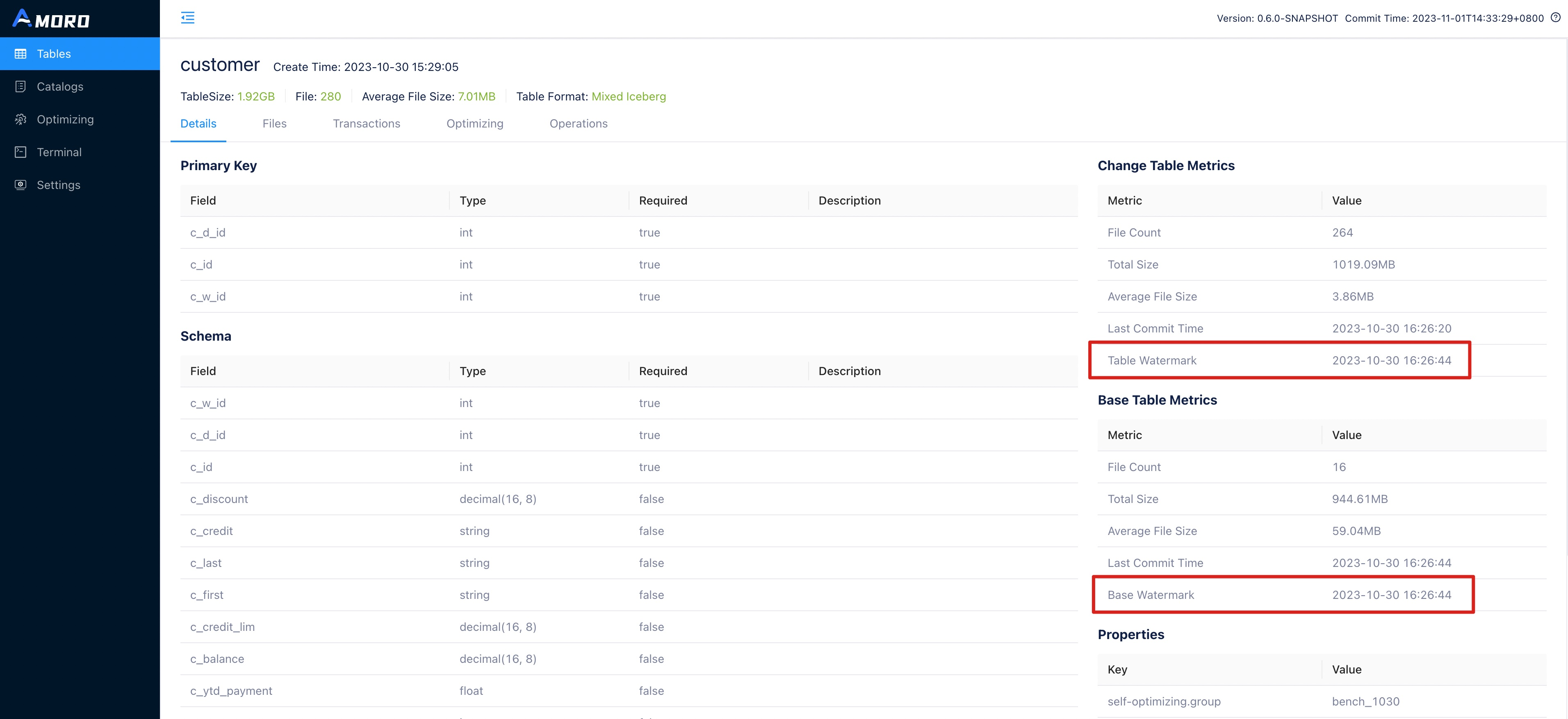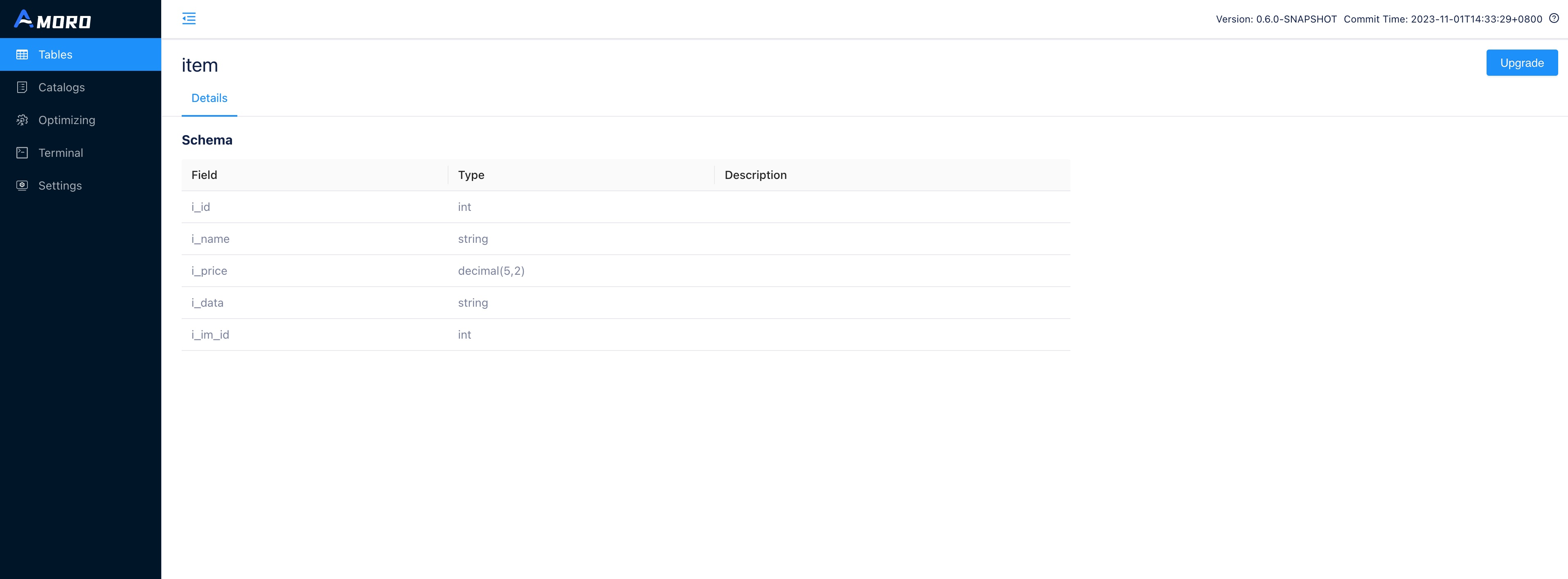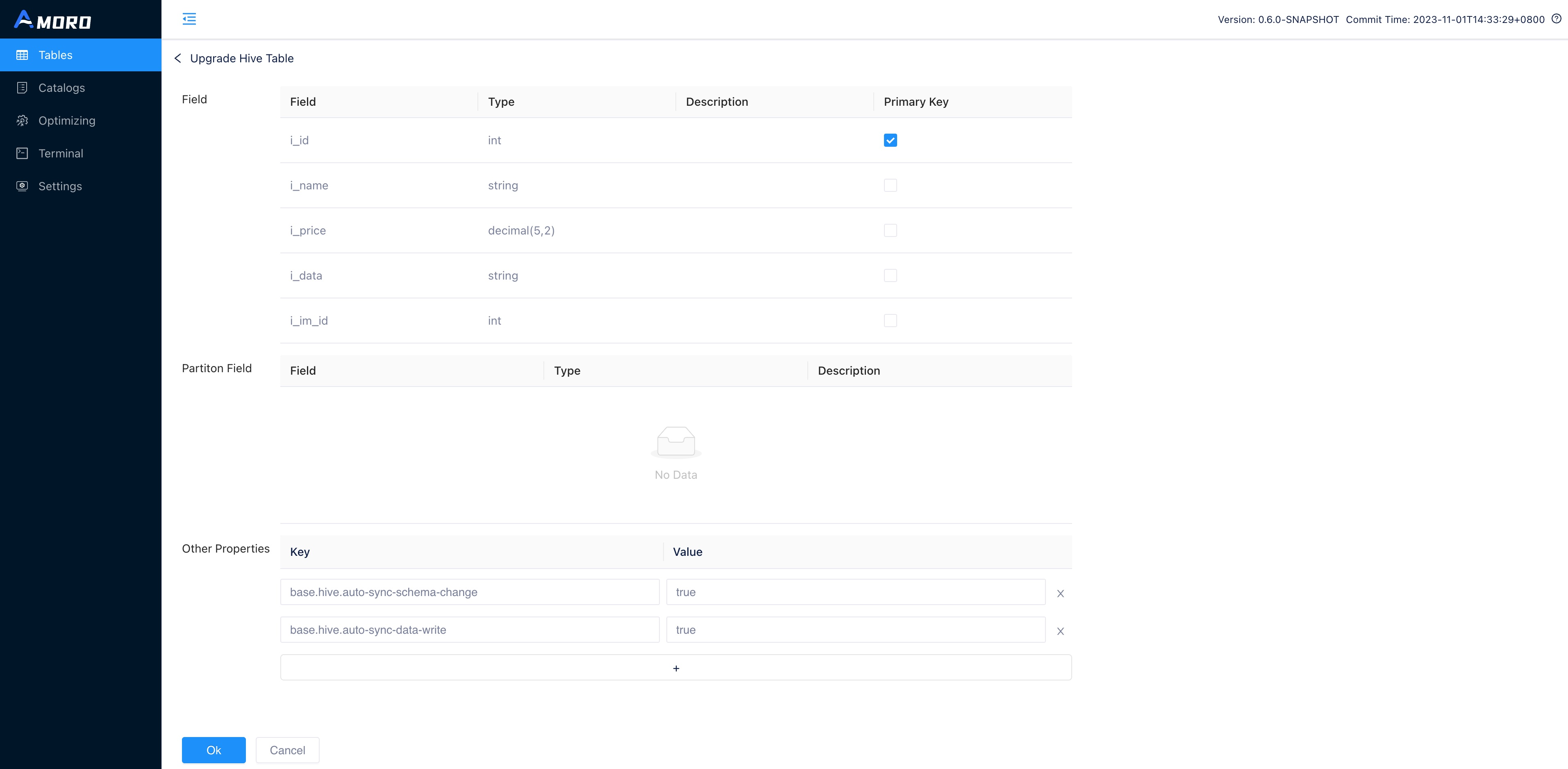Using Tables
The SQL execution tool Terminal is provided in AMS dashboard to help users quickly create, modify and delete tables.
It is also available in Spark and Flink and other engines to manage tables using SQL.
Create table
After logging into AMS dashboard, go to Terminal, enter the table creation statement and execute it to complete the table creation.
The following is an example of table creation:
create table test_db.test_log_store(
id int,
name string,
op_time timestamp,
primary key(id)
) using arctic
partitioned by(days(op_time))
tblproperties(
'log-store.enable' = 'true',
'log-store.type' = 'kafka',
'log-store.address' = '127.0.0.1:9092',
'log-store.topic' = 'local_catalog.test_db.test_log_store.log_store',
'table.event-time-field' = 'op_time',
'table.watermark-allowed-lateness-second' = '60');
Currently, terminal uses Spark Engine for SQL execution. For more information on the syntax of creating tables, refer to Spark DDL. Different Catalogs create different table formats, refer to Create Catalog
Configure LogStore
As described in Mixed-Iceberg format, Mixed-Iceberg format may consist of several components, and BaseStore and ChangeStore will be automatically created upon table creation. LogStore, as an optional component, requires separate configuration to specify, The complete configuration for LogStore can be found in LogStore Configuration.
In the example above, the Kafka cluster 127.0.0.1:9092 and the topic local_catalog.test_db.test_log_store.log_store are used as the LogStore for the new table. Before executing the above statement, you need to manually create the corresponding topic in the Kafka cluster or enable the automatic creation of topics feature for the cluster.
Configure watermark
Watermark is used to describe the write progress of a table. Specifically, it is a timestamp attribute on the table, indicating that all data with a timestamp smaller than the watermark has been written to the table. It is generally used to observe the write progress of a table and can also serve as a trigger metric for downstream batch computing tasks.
In the example above, op_time is set as the event time field of the table, and the op_time of the written data is used to calculate the watermark of the table. To handle out-of-order writes, the permitted lateness of data when calculating the watermark is set to one minute. You can view the current watermark of the table in the table details on the AMS Dashboard at AMS dashboard.

You can also use the following SQL statement in the Terminal to query the watermark of a table:
SHOW TBLPROPERTIES test_db.test_log_store ('watermark.table');
You can expect to get the following results:
+-----------------+---------------+
| key | value |
+-----------------+---------------+
| watermark.table | 1668579055000 |
+-----------------+---------------+
Modify table
After logging into the AMS dashboard, go to the Terminal and enter the
modification statement to complete the table modification. The current Terminal uses Spark Engine to execute SQL. For
more information on modifying tables, please refer to the syntax guide Spark DDL.
Upgrade a Hive table
Amoro supports Mixed-Hive format table, which combines the capabilities of Hive formats to directly implement new table formats on top of Hive.
After logging into the AMS dashboard, select a table under a certain Hive Catalog from the Tables menu to perform the upgrade operation.

Click the Upgrade button in the upper right corner of the table details (this button is not displayed for Hive tables that have already been upgraded).

On the upgrade page, select the primary key for the table and add additional parameters, then click OK to complete the upgrade of the Hive table.
Configure self-optimizing
Amoro provides a self-optimizing feature, which requires an active optimizer in the Optimizer Group configured for the table.
Modify optimizer group
To use an optimizer launched under a specific optimizer group to perform self-optimizing, you need to modify the self-optimizing.group parameter of the table to specify a specific resource pool for the table.
The setting method is as follows:
ALTER TABLE test_db.test_log_store set tblproperties (
'self-optimizing.group' = 'group_name');
In default,'self-optimizing.group' = 'default'。
Adjust optimizing resources
If there are multiple tables to be optimized under the same Optimizer Group, you can manually adjust the resource proportion of each table by adjusting the quota.
ALTER TABLE test_db.test_log_store set tblproperties (
'self-optimizing.quota' = '0.1');
For more information, please refer to Self-optimizing quota。
Adjust optimizing parameters
You can manually set parameters such as execution interval, task size, and execution timeout for different types of Optimize. For example, to set the execution interval for minor optimizing, you can do the following:
ALTER TABLE test_db.test_log_store set tblproperties (
'self-optimizing.minor.trigger.interval' = '3600000');
More optimization parameter adjustment refer to Self-optimizing configuration。
Enable or disable self-optimizing
The Optimize of the table is enabled by default. If you want to disable the Optimize feature, execute the following command. Conversely, you can re-enable it:
ALTER TABLE test_db.test_log_store set tblproperties (
'self-optimizing.enabled' = 'false');
Configure data expiration
Amoro can periodically clean data based on the table’s expiration policy, which includes properties such as whether to enable expiration, retention duration, expiration level, and the selection of the field for expiration. it’s also necessary for AMS to have the data expiration thread enabled. You can enable the ‘data-expiration’ property in the configuration file
Enable or disable data expiration
By default, Amoro has data expiration disabled. If you want to enable data expiration, please execute the following command.
ALTER TABLE test_db.test_log_store set tblproperties (
'data-expire.enabled' = 'true');
Set the data retention period
The configuration for data retention duration consists of a number and a unit. For example, ‘90d’ represents retaining data for 90 days, and ‘12h’ indicates 12 hours.
ALTER TABLE test_db.test_log_store set tblproperties (
'data-expire.retention-time' = '90d');
Select the event-time field
Data expiration requires users to specify a field for determining expiration.
In addition to supporting timestampz/timestamp field types for this purpose, it also supports string and long field type.
String field require a date pattern for proper parsing, with the default format being ‘yyyy-MM-dd’. Additionally, long fields can be chosen as the expiration event time, but you need to specify the timestamp’s unit, which can be in TIMESTAMP_MS or TIMESTAMP_S.
Note that timestamp, timestampz, and long field types use UTC, while others use the local time zone.
ALTER TABLE test_db.test_log_store set tblproperties (
'data-expire.field' = 'op_time');
-- select string field
ALTER TABLE test_db.test_log_store set tblproperties (
'data-expire.field' = 'op_time',
'data-expire.datetime-string-pattern' = 'yyyy-MM-dd');
-- select long field
ALTER TABLE test_db.test_log_store set tblproperties (
'data-expire.field' = 'op_time',
'data-expire.datetime-number-format' = 'TIMESTAMP_MS');
Adjust the data expiration level
Data expiration supports two levels, including PARTITION and FILE. The default level is PARTITION, which means that AMS deletes files only when all the files within a partition have expired.
ALTER TABLE test_db.test_log_store set tblproperties (
'data-expire.level' = 'partition');
Delete table
After logging into the AMS Dashboard. To modify a table, enter the modification statement in the terminal and execute it.
Here is an example of how to delete a table:
DROP TABLE test_db.test_log_store;
The current terminal is using the Spark engine to execute SQL. For more information about deleting tables, you can refer to Spark DDL.